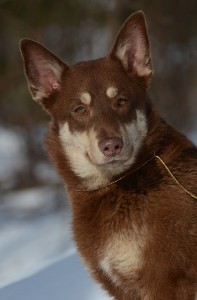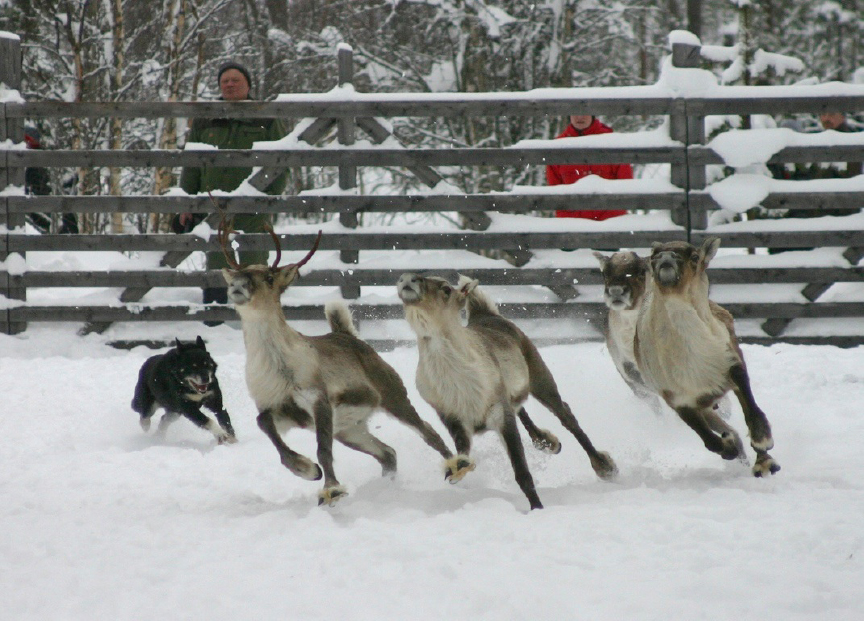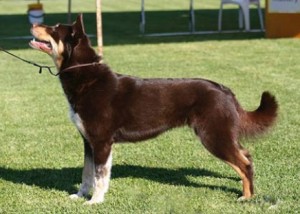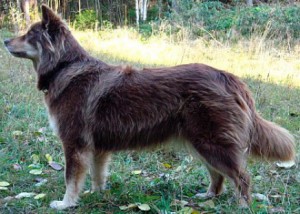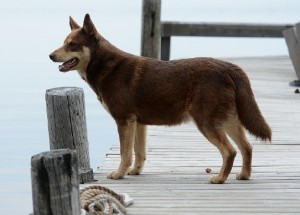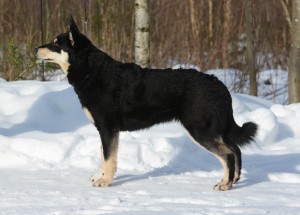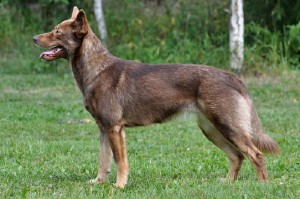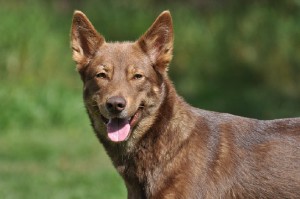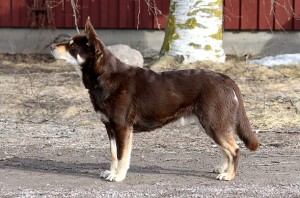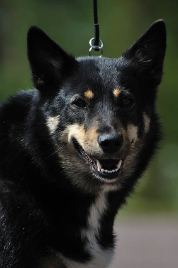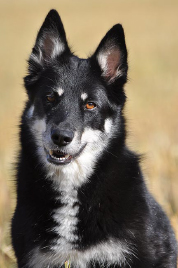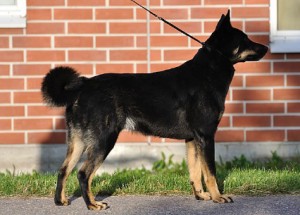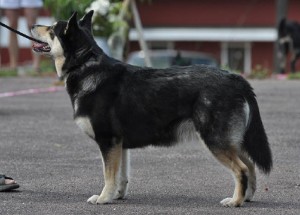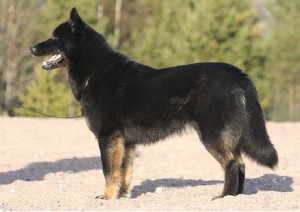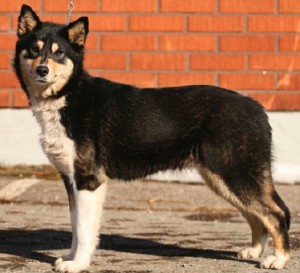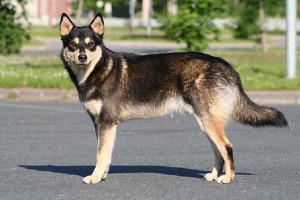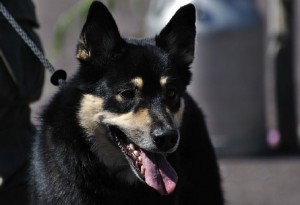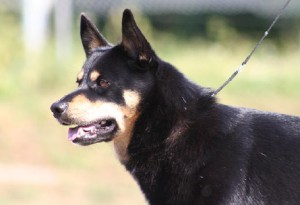Lapinporokoira
Reindeer herder.
Origin: Finland.
Release date of the official breed standard: 8-5-1997.
CLASSIFICATION FCI:
Group 5: Spitz and primitive types
Section 3: Nordic watchdogs and herders without working trial
BRIEF HISTORICAL SUMMARY:
For hundreds of years the Lapps have used dogs of the same type as Lapponian Herder as reindeer herders. Acceptance to the breed register was started in the 1950’s. At that time the modern Finnish Lapphund and the Lapponian Herder were still recognized as the same breed. The Lapponian Herder was separated into its own breed 10-12-1966, as it had been noted that two different reindeer herding breeds existed.
GENERAL APPEARANCE:
A herding spitz, medium sized, clearly longer than the height at the withers. The bone and muscles are strong. The dog is muscular, however must not give the impression of being havy. The sex should be clearly stamped. The coat is suitable adapted for the arctic climate.
BEHAVIOUR / TEMPERAMENT:
Docile, calm, friendly, energetic and willing to serve. Barks readily when working.
HEAD:
Elongated, the muzzle is slightly shorter than the skull.
Skull : Only slightly convex. The frontal furrow is marked and the superciliary ridges are clearly defined.
Stop : Gently sloping.
MUZZLE:
The nasal bridge is straight. Viewed above and in profile the muzzle tapers evenly towards the nose.
LIPS:
Tight.
JAWS/TEETH:
Jaws and teeth are strong. Scissor bite. Normal dentition.
CHEEKS:
The zygomatic arches are clearly marked.
EYES:
Preferable dark in colour, yet harmonizing with the coat colour. Lively and set rather apart. Oval shaped. The expression is keen, in bitches also devoted.
EARS:
Pricked, medium in length, set rather apart, rather broad at seton. The inside of the ear is covered with profuse hair, particularly at the base.
NECK:
Strong and medium in length, set smoothly into the shoulders. Without dewlap.
BODY:
Withers: Marked
Back: Strong and muscular.
Loin: Short and muscular.
Croup: Rather long and slightly oblique.
Chest: Deep, long and spacious, not very broad. The ribs are clearly arched.
Underline: Genly tucked up.
TAIL:
Medium in length, low set and covered with profuse hair. In repose the tail is hanging. In movement it is held in a loose curve, but may not raise over the back. The tail action may also be circular.
LIMBS:
FOREQUARTERS
General appearance: Powerful, attached to the body with strong muscles, yet free in movement. Muscular and well angulated. Viewed from the front straight and parallel.
Shoulders: Oblique and muscular.
Elbows: Turning neither inwards nor outwards, close to the body, pointing straight backwards.
Forearm: Vertical.
Carpus: Sinewy and flexible.
Pastern: Seen in profile slightly oblique, enabling the flexible movement.
Forefeet: Rather oval with all sides, also underneath, covered with dense hair. The toes are well arched, the pads elastic and thick.
HINDQUARTERS
General appearance: Well angulated. Viewed from behind straight and parallel.
Upper thigh: Rather long and broad with well developed muscles.
Stifle: Pointed forward, the angulation is clearly marked.
Under thigh: Rather long and sinewy.
Hock joint: Set rather low, the angulation is clearly marked.
Metatarsus: Rather short, vertical and parallel.
Hindfeet: As front feet. Preferably without dewclaws.
GAIT/MOVEMENT:
Free, flexible, effortless and sound. The trot is tireless. At a fast trot tends to single-track.
SKIN:
Tight overall without wrinkles.
COAT:
The outer coat is of medium length or long, straight, rather erect and harsh. The undercoat is fine and dense. The hair is often more profuse and longer on the neck, chest and on the backside of the thighs.
COLOUR:
Black in different shades, even greyish or dark brown with a lighter shade than the basic colour, greyish or brownish colour markings orten on the head, the lower parts of the body and legs. White markings on neck, chest and legs are permitted. The undercoat is black, greyish or brownish.
SIZE:
Ideal height for males 51 cm (with a tolerance of ± 3 cm)
Ideal height for females 46 cm (with a tolerance of ± 3 cm)
FUALTS:
Any departure from the foregoing points should be considered a fault and the seriousness with which the fault should be regarded should be in exact proportion to its degree.
Males not masculine and females not feminine.
Very light eyes in black dogs.
Ears with slack tips (tipped ears).
Tail curled or curved over the back.
Soft, wavy or flat coat.
Without undercoat.
ELIMINATING FAULTS:
Overshot or undershot mouth.
Drop ears.
Male animals should have two apparently normal testicles fully descended into the scrotum.
Additional Information
Welcome to the world of an excellent working and companion dog from Finland
The Lapponian Herder is first and foremost a working dog. Minor breed-typical details must neverbe considered more important than sound conformation, movement and a coat appropriate for working in harsh weather conditions. Fit for Function.
Lapponian Herder
Judges’ Guide
The Lapphund Club of Finland 2010, revised 2017
Photos by Kaisa Hurme, Taru Vallius, Marja Talvitie and unknown photographers
Translation by Petra Palukka
The Lapponian Herder was split from the Finnish Lapphund on 10 Dec 1966 when it was realised that two different types of reindeer-herding dogs existed.
For hundreds of years, the Sami people had used dogs resembling the Lapponian Herder for herding reindeer. A systematic collection and registration of stock started in the 1950s when the Finnish Lapphund and the Lapponian were still seen as one single breed.
As an actual breed the Lapponian Herder is still young, however, the stock is already relatively uniform. The breed register is still open and new Lapland-originated specimens have been granted a special entry into the register all along, which, of course, makes the breed type and conformation more varied. Furthermore, because of the common background with the Finnish Lapphund there are Lapponian Herders that express Finnish Lapphund-like features. Although the dogs, especially those with several generations of registered stock in their pedigrees, are very uniform in type, a certain variation and diversity should be maintained in the breed.
The Lapponian Herder is considerably longer than tall: a male is about 10 per cent and a female about 15 per cent longer that the height at the withers. There are short-bodied and downright square-proportioned dogs that often have inadequate angulation. When evaluating the length of the body, the dog should have a well-angulated, strong front, long ribcage and strong rear with broad thighs combined with a short loin and back. A short-bodied dog with correct conformation is preferable to a longer-bodied dog with a long back and loin (two factors that make a dog less durable). The depth of the ribcage is approximately half of the height at the withers. A Lapponian Herder should not appear rangy and leggy, however, one does come across dogs like that in this breed quite often. When evaluating the overall appearance, the main focus should be on correct proportions and balance both standing and on the move, as well as on durability. A Lapponian Herder must have the stamina to work for long periods under tough and challenging circumstances in a very harsh climate.
More excellent specimens with excellent coats and proportions.
Very nice representatives of the breed, both of them almost in full coat. Good coat textures, the black/tan has a somewhat wavy coat, which is OK and often a display of good coat quality.
Good examples of dogs “wearing bikinis”. Left picture: excellent rear, however the upper arm is rather upright, which is a very common fault these days.
Slightly different types of heads, both are OK, however, the bitch displays a more beautiful profile.
The very first breed standard, and every revision since, has called for a long or medium long coat. Pictured are excellent examples of long coats, which unfortunately were lost for a long time. A common fault today is way too short outer coats.
BEHAVIOUR/TEMPERAMENT:
Docile, calm, friendly, energetic and willing to serve. Barks readily when working.
“Barks readily when working” does not imply that the Lapponian Herder would bark a lot all the time. It should only bark while working – at other times the Lapponian Herder is very much a quiet and calm dog.
In the show ring, a Lapponian Herder must be calm and never under any circumstances be ill-behaved or show any aggressiveness. It is characteristic of Lapponian Herder bitches to show excessive submissiveness.
HEAD
Elongated, slightly wedge-shaped, never light or refined. Always either masculine or feminine. Skull relatively broad at the ear set, top of the head only slightly convex. Stop gently sloping, however, clearly marked. Superciliary ridges are clearly defined, especially on males. Zygomatic arches are clearly marked but not too strongly pronounced.
EARS
Pricked, medium in length, set rather apart, but not too wide. Rather broad at set-on, not quite pointed. The inside of the ear is covered with profuse hair that protects it from insects. There are Lapponian Herders with too large ears, and sometimes one comes across tipped ears, which must be penalised in the show ring. Drop ears are a disqualifying fault.
EYES
Oval shaped, set rather apart, brown in colour, brown dogs have slightly lighter eyes but never yellow. Blue eyes are a disqualifying fault.
MUZZLE
Slightly shorter than the skull, tapers evenly but only slightly towards the nose, never snipey. The nasal bridge is straight. There are some weak, too light muzzles as well as weak bottom jaws. Lips are tight.
NOSE
Dogs with black pigment have a black nose. Brown dogs always have a brown nose.
BITE
Scissor bite. Level bite acceptable especially for older dogs. A clearly overshot or undershot bite is a disqualifying fault. Missing teeth should be mentioned in the written critique.
EXPRESSION
Keen and placid, in bitches also devoted.
BODY
Relatively sturdy, but not heavy. Withers are marked, but not too strongly pronounced. The anticlinal vertebra (dip behind the withers) is often clearly pronounced and should not be mistaken for a swayback. The back line is strong and level, not sloping. The loin is short and the croup is long and slightly sloping, which contributes to a broad and muscular thigh. Viewed from above, the croup is relatively broad, especially on bitches. Steep and/or short croups are a common fault in this breed. In such cases, rear leg muscles do not have as much room to attach to bones and subsequently such dogs cannot move with sufficient efficiency and power. The chest is long and deep, but must not reach below the elbows. The forechest is clearly visible, however, not exaggerated.
TAIL
Medium in length, low set. In repose the tail is hanging. The Lapponian Herder uses its tail to balance its movement, and on the move carries its tail level with the back line or slightly above it. Tail carried in a sickle shape on the move is acceptable as long as it does not curve tightly over the back. The tail is a mood indicator in this breed. Especially when the dog is greeting someone the tail movement tends to be circular. The tail is covered with profuse, thick hair. A noticeable kink (ossified vertebrae) is a disqualifying fault.
Good tails and proportions, a youngster on the right & an adult on the left.
LIMBS AND MOVEMENT
Limbs are strong-boned, muscular and well angulated. While standing, the limbs are straight and parallel viewed from the front and behind. On the move, the Lapponian Herder tends to single-track (especially at a fast trot), which should not be mistaken for narrow movement. The angulation is relatively clearly marked. Furthermore, it is vital that the front and rear angulation is balanced; only such a dog is capable of trotting in a sound and efficient manner. Shoulder blades are oblique and the upper arm is equally long as the shoulder blade. Elbows are tight and close to the body. Some Lapponian Herders have short upper arms and subsequently hackneyed front movement. Pasterns are slightly oblique. Flexible but not loose, they act as efficient shock absorbers. Hindquarters are well angulated. Upper thighs are broad and muscular. Hocks are rather low and thereby enable powerful rear movement. Feet are oval in shape and strong with all sides, also underneath (between the pads), covered with dense, protective hair. Movement must be efficient, flexible, sound and effortless.
The Lapponian Herder must move with a durable, long-stepping, ground-covering, low trot. A dog moving with powerless, short-stepping gait is not suitable for the tough reindeer herding working conditions.
COLOUR
Black and tan, wolf sable (grey), brown or solid black. Cream, sable, and brindle are disqualifying colours. White markings on head, chest, neck and legs are permitted. In the new breed standard, also dilute colours are disqualifying.
SIZE
Height at the withers males 51 +– 3 cm, females 46 +– 3 cm. Even slightly more tolerance is accepted if the dog is of excellent type.
TEMPERAMENT
As important as conformation and breed type are, temperament is the most important factor in a dog. A beautiful dog is useless
if it has a bad temperament. Due to time constraints, temperament can only be evaluated rather superficially in the show ring. The Lapponian Herder is clever and willing to learn. These qualities cannot be fully evaluated in the show ring, however, they shine through even in a short period of time. The Lapponian Herder is calm and friendly. It may be rather indifferent towards strangers, and bitches in particular can be downright aloof.
Any aggressiveness towards people is a disqualifying fault. What is more, dogs must not growl or bark at each other in the ring.
COAT
The outer coat is of medium length or long, straight and harsh. The undercoat is fine, dense and plentiful so that the dog can survive in the Arctic climate. The outer coat is rather erect instead of flat or “body-hugging”. Furthermore, it has to be fully weather-protecting and moisture-repellent. Too short or too soft coats are common faults in this breed. This is something that should be paid more attention to. The Lapponian Herder is certainly not a short-coated breed but should have at least a medium length coat.
Good heads even though slightly different.


